Published in the February 2022 issue of “Die Porsche Kassette”
Ⓒ2022 Technolab / PedrosGarage.com

For more information about restoration, seatbelts and more, please visit my website: www.PedrosGarage.com.
Happy Porsche'ing,

During the last year and a half (through most of the Pandemic) I’ve finally been restoring my 1998 Boxster. She’s 24 years old now and with 300,000 miles on the clock it was due time.
I had done a lot of the “invisible” work already: Performance upgrades such as fully modified air intake, equal length headers, Pedro Sport Exhaust, ECU tuning, larger brakes, adjustable suspension and droplinks among others but now was it was time for the eye-candy!
I decided to restore it to my vision of what I would have wanted the car to be from the factory. That meant some exterior mods (adding side skirts), removing all the dings and full-body paint, but keeping the same Glacier White color. A new convertible top was also now a must. I never liked the small glass rear window, so I kept the original top with the big, clear plastic window, and finally a new carbon-fibre hood with a monochrome Porsche Crest to point the way!
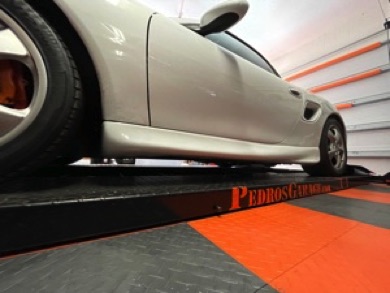
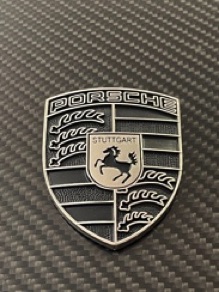
Then it was time for the interior. Here I decided to create a unique Wolfsburg edition 986. I searched hi and low for the specific material I had in mind and finally found it. The interior was originally full graphite gray leather. I decided that to better integrate the fabric inserts she needed a two-tone leather restoration so black and gray it is.
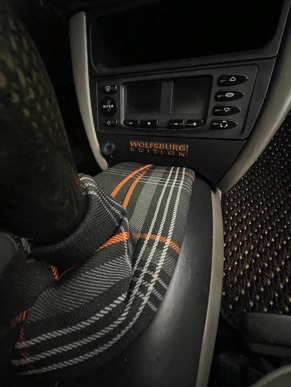
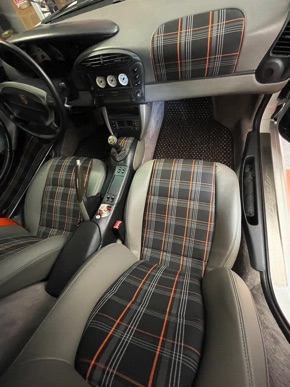
Finally for the “pièce de résistance” I wanted deviating color seatbelts! Obviously, with the interior changes, orange was the obligatory color.
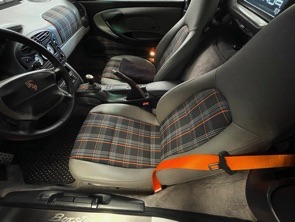
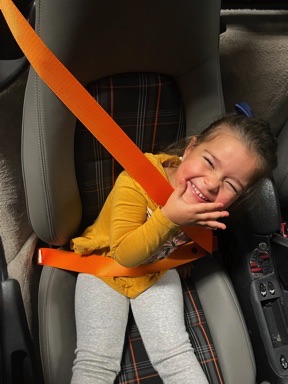
My youngest granddaughter really liked them!
Because I am a Club Racing Scrutineer, we are trained to look at every racecar’s seatbelts before every race while doing the mandatory safety checks. In a racecar, seatbelts cannot be more than 5 years old and they cannot show any signs of abrasion, stretching, or any other type of damage. If they do, the racecar owner must replace them by the next race or they can’t go on track until they do. It’s that important.
Trying to correlate that to my car, my OEM seatbelts were 24 years old and because it’s a convertible, they’ve been subjected to many hours of direct UV light and probably rolled and retracted close to 15,000 times! (I figure, to be conservative, twice a day times 20 years). So the decision to replace was a sound one.
Since I’m a one-man-band and a DIY’er, I figured that I would find out the length of each side of the seatbelts, go online and order the 2 inch webbing material from the many resellers, pick the perfect orange tone and replace it myself since I have a sewing machine and some strong thread material.
Piece of cake ….. well, not so fast.
It turns out that the vast majority of the 2” webbing material sold online (and offline as well) is not intended to be used for seatbelts, but rather as strapping and or towing material. Some of them, many from China may even have “DOT Approved” stamped on them. Anyone not knowing the whole story could think it’s legit, but DOT regulates tire manufacturing, not seatbelts. Seatbelts are regulated by the Federal Motor Vehicle Safety Standards (FMVSS) which are issued by the National Highway Traffic Safety Administration NHTSA and can be very, very complex and very difficult to comply with. Because of those regulations there are just a handful of legitimate seatbelt-webbing manufacturers worldwide. Those regulations require, among others: G-Force testing, Tilt Lock testing, Webbing Abrasion testing, Salt Spray testing, Tensile test at 10,000 lb., Tensile test at 5,000 lb. as well as Retractor Cycling test.
To be approved, seatbelts must comply with:
• FMVSS Safety Standard #209 which specifies requirements for seatbelt assemblies. The requirements apply to straps, webbing or similar material, as well as to all necessary buckles and other fasteners and all hardware designed for installing the assembly in a motor vehicle and to the installation, usage, and maintenance instructions of the assembly.
• FMVSS Safety Standard #302 which specifies burn resistance requirements for materials used in the occupant compartments of motor vehicles. Its purpose is to reduce death and injuries to motor vehicle occupants caused by vehicle fires, especially those originating in the interior of the vehicle from sources such as matches or cigarettes.
• Society of Automotive Engineers - SAE #J386 which establishes the minimum performance requirements for pelvic restraint systems necessary to restrain an operator or passenger with a rollover protective structure (ROPS) in the event of a machine rollover.
The FMVSS also regulates the type of thread material used to finish the belt at the anchor points as well as the type of sewing machine used and the pattern of the stitching to finish the belt.
It also requires that the manufacturer and the date of manufacturing be sewn in into a tag at the bottom of the belt.
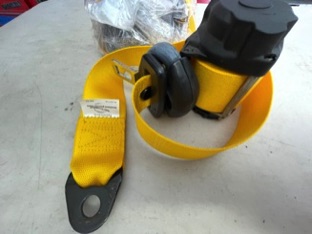
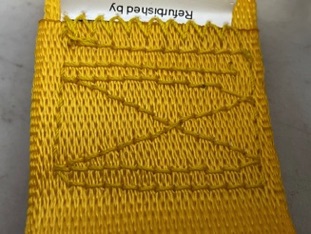
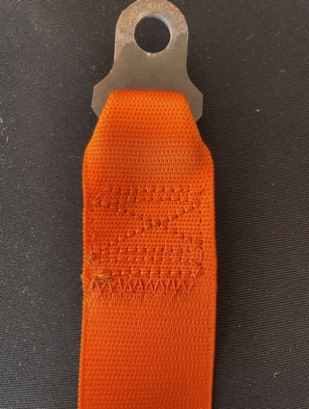

By the way, the OEM supplier to Porsche for seatbelts is the Berger Group which was founded in 1968 in Alfdorf, Germany by Johan Berger and now has factories in Belgium, Spain, Germany and China. They are also the OEM supplier to: Audi, Volkswagen, Lamborghini, BMW, Mercedes Benz, Mini, Ford, Jaguar, Volvo, Opel, Skoda and Hyundai among others.

